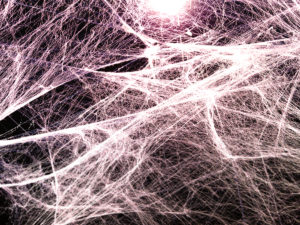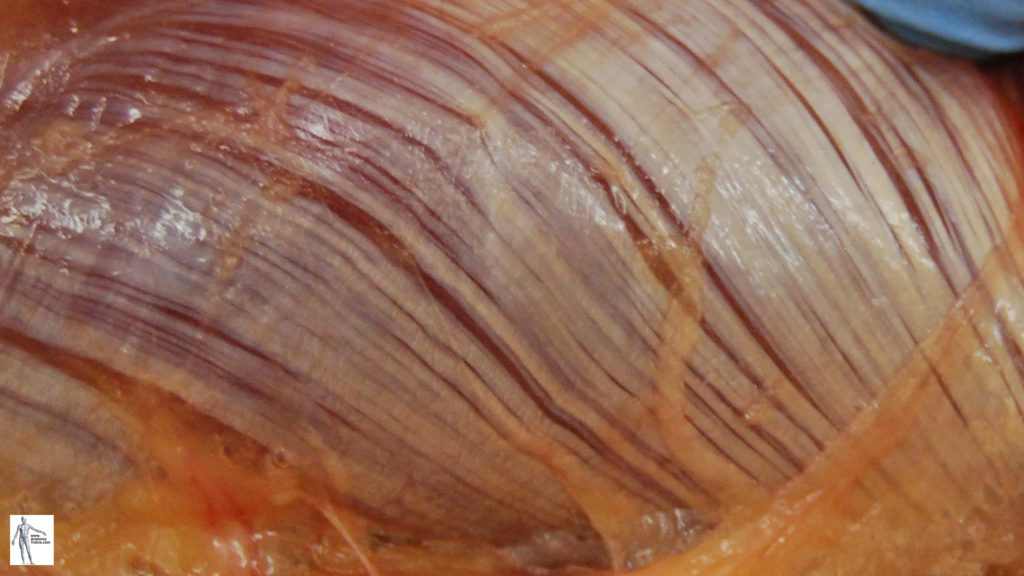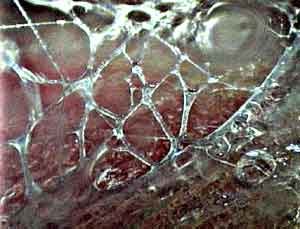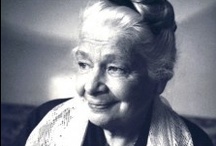Fascia
is today’s buzzword in the field of bodywork;
in fact, there are lots of new therapies with fascial
in their name. But fascia is also shorthand for a
groundbreaking new way of seeing our biomechanics
that every hands-on therapist should understand.
MY FASCIA STORY
I was first introduced to the word fascia in early 1974, when I made the acquaintance of Dr. Ida P. Rolf in California. At the time, I had no more than a passing interest in the word or its implications—I was simply amazed at what Dr. Rolf could do with her hands.
It was the opening day of a Rolfing class in a slightly tacky motel meeting room on Santa Monica Boulevard. All the students (and some other interested people like myself) were gathered to get more of the skinny on this new thing called Rolfing we’d been hearing about —“it’s so strong,” and “it hurts,” and “it’s cool.”
Dr. Rolf was in her 70s, white-haired and slightly stooped, but still strong in voice, hands, and character. She gave her stump speech about fascia and human pattern change, and then she did a demonstration of her first hour in the 10-session Rolfing recipe.1 For her model, she chose Steve, a man I knew well and lived with in a communal house in Laurel Canyon (hey, it was the ’70s). Steve was one of those people who looked normal from the front, but from the side looked as thin as a piece of paper. He was so collapsed his chest nearly touched his back, meaning he was pulled down in what I would today call his Superficial andDeep Front Line.2 He lay down and Dr. Rolf set to work on his rib cage, prodding and shifting very specific tissues with a direct, even painful, determination.
But how effective! When Steve stood up 30 minutes later, he was visibly deeper in his chest, even to my untrained eye. His breath was slower and showed more rib excursion. His voice was deeper and—Did I make this up? I don’t think so—more emotionally resonant. Those changes sustained over the coming days and weeks, and I saw how Steve interacted differently with our housemates.
I signed up for the bodywork immediately and had my 10-session series in conjunction with the class. Again, it was not the theory but the effects that won me over. Yes, it was painful (more painful than it needed to be, honestly) and it was strange to have someone using their knuckles and elbows on some really sensitive spots of my anatomy. But it was fascinating to record the physical changes. Still more fascinating, and what sold me on becoming Dr. Rolf’s student, was the emotional development I felt in myself and my housemates noticed in me. How can working on the body promote emotional development? Fascinating. Fascia-nating, maybe.
As I transitioned from bodywork recipient to neophyte student, I certainly paid more attention to fascia, because at that time, the emphasis on fascia is what made Dr. Rolf’s work unique. “We’re working the fascia,” we said, “not the muscles.” Of course, we had no idea what we were talking about at that time. You cannot work the fascia without also working the muscles and the neurovascular substrate. Thus, the debate began about whether fascial work is a subset of massage or should better be seen as a subset of osteopathic manipulation, as Ida would have placed it. Dr. Rolf’s own journey started first with yoga in an attempt to help her spinal arthritis, but yoga in the 1920s had zero anatomy and next to no explanation for how it worked physiologically. Soon, Dr. Rolf blended osteopathy into her mix, and the early osteopaths were hip to fascia; Dr. Andrew Taylor Still even wrote a book about it, summed up in the famous quote: “I know of no part of the body that equals the fascia as a hunting ground. I believe that more rich golden thoughts will appear to the mind’s eye as the study of the fascia is pursued than of any other division of the body.”3
So, when I say that Ida Rolf was a lone voice crying, “Fascia!” in the wilderness at that time, understand that the study of fascia had been going on uninterrupted from the 16th century, when Andreas Vesalius (1514–1564) pioneered the technique of “clearing off” the fascia to reveal other structures, and then on through Antonio Scarpa, Edward Singer, and others.4 Nevertheless, modern anatomy chooses to deal with the fascial system in terms of its named parts— the thoracolumbar fascia, the iliotibial tendon, the medial collateral ligament— and the idea of fascia as a system pretty much dropped off the radar for most professionals in the physiotherapy, massage, chiropractic, and rehabilitation fields in the 20th century. So, Ida Rolf did not “invent” fascia, but she was responsible for tuning a lot of people in to the fascial story.
Once I get my teeth into something, I want to know all about it, and Dr. Louis Schultz, Ida’s anatomist and author of The Endless  Web (North Atlantic Books, 1996) and Out in the Open (North Atlantic Books,1999), was really my door into the fascinating world of the anatomy and physiology of fascia. His idea that we are “lifelong embryos”5 really seized my imagination: we use the adaptive nature of our fascial system— what we now know as connective tissue “plasticity” and “remodeling”—to handle the chronic and acute forces through the shifting priorities of our days and lives.
Web (North Atlantic Books, 1996) and Out in the Open (North Atlantic Books,1999), was really my door into the fascinating world of the anatomy and physiology of fascia. His idea that we are “lifelong embryos”5 really seized my imagination: we use the adaptive nature of our fascial system— what we now know as connective tissue “plasticity” and “remodeling”—to handle the chronic and acute forces through the shifting priorities of our days and lives.
Our fascia does its physiological best to adapt to accidents, surgeries, and our own bad habits and excesses, not to mention our modern sedentary lifestyle that weighs on our ability to move well in

The “cotton candy” of myofascia in the muscle—a picture of the perimysium among the muscle fi bers from Rolfer Ron Thompson (above), and a picture of the epimysium around the outside of the vastus lateralis in the quadriceps (below). Images courtesy Thomas Myers.
gravity.6
In kinesiology texts, we learn about Newton’s laws of motion, inertia, vectors, and three types of levers, but is that how our biomechanics really work? God (or your mom, or Darwin—choose your source) makes joints that last longer than the fi nest metal, plastic, or ceramic joint replacements we can invent. How does that happen?
In the ’70s, there was very little written material about fascia. We understood it at first as “the plastic wrap around the muscles” and asserted that “fascia connects everything.” It was what the hunters called the “blue” or “silver” skin under the regular skin, and constituted the gristle and the sinews in common parlance—the white stuff in meat. Honestly, we ascribed all kinds of magical properties to the fascia in terms of energy and spiritual enlightenment.7 And we all had our miraculous tales of healing—as we all do, regardless of our modality.8
Some of these ideas really did turn out to be true. I had studied previously with Buckminster Fuller and was part of bringing his engineering concept of tensegrity to bear on fascia’s role in holding up the body.9 Understanding the dynamic balance between tension and compression (the yin and yang of biomechanics) is still crucial to taking on new holistic strategies among muscle, bone, and fascia, and tensegrity is still, to my mind, the best way to understand the dynamics of human structure.10
Fascia is not new;
awareness
of fascia is.
I began to teach anatomy (the best way to learn it) for holistic practitioners, including the students at the Rolf Institute. Out of that teaching, and my practice, developed the “in-series myofascial force transmission” idea11 that would later become my book Anatomy Trains (Churchill Livingstone, 2001) in which I summarized all I had gleaned about fascia up to that point.
But a rich harvest of reliable knowledge began to arrive with the advent of the Fascial Research Congresses starting in Boston in 2007.12 These congresses have unearthed and brought together many disparate lines of inquiry into fascia from around the world.
For example, I learned a great deal about how muscle and fascia interact at the smallest level from some research from Canada in meat science. What makes meat tough? Too much fascia—so they were doing great basic research on how it worked. Without these conferences to bring together all the disparate scientists, who would have known?
Today, the available knowledge for practitioners has grown so much that fascia has become a buzzword—everybody is adding fascial to whatever they do, without a lot of knowledge of how, specifically, they are affecting the fascia.13
FASCIAL DEFINITIONS
Aside from turning our knowledge base up from 2 to 11, these research conferences have also (inevitably, in science) thrown up terminological questions that I am going to sidestep for now. On the one hand, fascia is a perfectly good medical term of dissectible bundles of collagenous tissue. But now, contemporary practitioners are repurposing the word for something else.14
With the work of Dr. Jean-Claude Guimberteau (see page 54), Dr. Peter Huijing, Dr. Jaap van der Wal, and the Stecco family, it has become evident that the common practice of using a scalpel to differentiate structures within the fascial web was problematic at best, perhaps even a mistaken notion.15 Except for the open spaces in the synovial joints, every layer of fascia is tied into its neighbor. Continuity is the rule, and separation was the exception—healthy in a synovial joint, but indicative of inflammation almost everywhere else.

As the only film of living fascia we have, the work of Jean-Claude Guimberteau, MD, revealed the world of fascia alive and adapting within the living human. body. Until his work, so many of our concepts were based on dead fascia. Image courtesy Jean-Claude Guimberteau, MD.
We are 70 trillion cells, all knit together as a unit by this fascial web. But the whole idea of a scalpel entails separation of one bit from another. As a result, the unity of the fascial net— and thus the appreciation of the system working together as a whole—was lost.
People like me use the word fascia in this much more general way, meaning “the fascial system” and the fibrous webbing taken as a whole, though this also leaves
us with fuzzy boundaries. In the division of tissues within the body, connective tissue is one of four; the other three are neural, epithelial, and muscular. Within the connective tissues, there are gazillions of red and white blood cells, but these are not usually included when we think of the fascial system, our structural body. So, connective tissue network is too broad a term.
Our structural body is certainly sinewy, with white collagen and yellow elastin holding every organ together— loosely knit in the breast and pancreas, for example, but tightly woven in the tendons, outside of the leg, and the low back. These materials—all the bluish-white fibrous tissue that surrounds the muscles, joints, organs, and neurovascular bundles—are all manufactured and extruded into the intercellular space by the fibroblasts (fiber making cells) and their cousins (including osteoblasts, chondrocytes, and mast cells). This comes close to describing what most people understand as the fascial system.
But then we have to add in all the gels or glycosaminoglycans (GAGs) we see in Dr. Guimberteau’s work. These hydrophilic sticky viscous gels are a very adaptable part of the fascial system and critical to understanding its properties in training and rehabilitation.16
Even if we add these gels to the fibers and the cells, there is still some room for controversy in that our current understanding of how this system works extends beyond this definition in both the macro- and the microdirections: (1) that the fibrous network extends into the cartilage and bone (hard connective tissues, as well as soft), and that given their similar construction and responsiveness to changing forces, they should be included in our fascial thinking (but only in my opinion; my friend Robert Schleip, PhD, would disagree); and (2) recent research has carried the idea of that “responsiveness to changing mechanical conditions” below the level of dissectible bits right down into the nucleus of the cell and the propagation of the DNA.17
BIOMECHANICAL AUTO-REGULATION
Because of the nomenclature issue, I propose another term (just what we need, more verbiage, but I feel it is apt): the Biomechanical Auto-Regulatory System (BARS). We have to stop thinking about what we can do with the plantar fascia to correct plantar fasciitis, and start seeing injuries and performance enhancement as a call for adaption in the whole BARS—from the microcosmic to the entire organism. I commonly get my best results for plantar fasciitis, for example, by working in other spots. Working the lower leg, the hamstrings, even the top of the neck offers better results than only working directly on the bottom of the foot.
Our BARS keeps us together, and it channels our movement. The nervous system animates the muscles and has a tremendous effect on our moment-to-moment stability, but the BARS also toils away on its own, creating overall year-to-year stability, repairing us (or not), and shaping itself to handle our common postural and movement patterns.
When we say median nerve, we understand it is part of a larger body-wide interactive syncytium called the nervous system. When we talk about the carotid artery, we understand that it lies within, and is affected by, the entire body-wide syncytium of circulation that controls fluid flow. Why, then, do we persist in the “parts” idea with the myofascial web, such as defining muscles in terms of origins and insertions, or thinking of the “plantar fascia” or “nuchal ligament” as a separate structure. Why not extend the same systemic realization to our fibrous body: all these named parts live within a similar totally connected and responsive fascial network?
The circulatory network does a marvelous job of sorting and transporting chemical supplies and messages all over the body to maintain our chemical and thermodynamic homoeostasis. The neural network evolved to carry electrochemical signals rapidly around the body and has been marvelously successful at coordinating our hands, feet, limbs, and trunk into a mighty tool for our brains to explore and test the world (and possibly screw it up beyond all recognition).
The BARS concept—and what is generally meant when this buzzword fascia is invoked—applies this same logic to the fascial system, which is engaged in the job of protecting our 70 trillion cells and keeping them in the proper relationship with each other. This is our biomechanical system, which works with tension and compression, and with the mechanical environment each cell lives in. Your BARS, your fascial system, is the context in which all your cells work—or not.
Each cell is adhered into this fascial network like Velcro, though some cells (e.g.,white blood cells) are more free to roam within it, while others (e.g., osteocytes) are much more held in place. This adhesive property of the cell membrane means that each cell is either in its “happy place” biomechanically, or it is too tensed or too compressed. The work of Donald Engber and his many followers has shown that cells do not do their job properly if they are in a mechanical environment not suited to their appointed task.18 In other words, there are diseases of “mechanotransduction,” and these are being explored.19
HOW FASCIA RESPONDS TO MANUAL THERAPIES, OR “WHY SHOULD I CARE?”
This new understanding—not only do cells need the right neural messages and the appropriate nutrition and peptides, they also need a healthy mechanical environment to work well—gives us a new way to interpret the interesting findings we get in our day-to-day practices.
Clients report improvements with constipation, headaches, an irregular heartbeat, or menstruation regulation— things you may not expect to remedy with massage. Of course, they ask you if these improvements are due to your work, and of course you want to say yes. But how do we really know? Maybe someday this will be measurable, but for now it is enough to know that improving biomechanics— through any manual therapy or movement approach—could not only amplify local circulation and bring feeling back through stimulating underused nerves, but also reposition the fascial tissues so that the cells in that area can breathe a sigh of relief and go back to their jobs. Releasing our cells from mechanical tension or pressure is the source of many of the unexplained healings we get in our sessions.
Cells act differently when they are mechanically stressed—either overstretched or overcompressed. The overstretched cells tend to abandon their job and put all their energy into reproduction. Overcompressed cells slow down their metabolic activity and, in extreme cases, can activate their apoptotic (suicide) gene and die.20 But there is a happy place in the middle, and, as we work with our clients to re-establish coherence in their posture and movement, it is not just the muscles that are happier—whole communities o f cells can be happier and better nourished, with room to move and function.
f cells can be happier and better nourished, with room to move and function.
This idea will fill in with the next 25 years of research, but the principle underlying it is simple: the glues that held neighboring cells together in early organisms like jellyfish extended themselves into more complex tissues (see illustration above) and then extended again into our yet more complex fascial body and skeleton. All these levels—the BARS—work together moment-by-moment. Every time you touch the fascia—in other words, when you touch someone—you affect the entire communicating network of fibers and gels, which communicates across the body, often at great distances from the site of your touch.
Fascia is not new; awareness of fascia is. Touch your clients with that awareness and your results will deepen as well. You are working with fascia whether you are aware or not. How much better could we do if we touched fascia consciously?
THE FASCIAL NETWORK
In equating the fascial network with the neural and circulatory networks, we must emphasize that the fascial network is the context in which all the others live. The nerves are completely surrounded by the connective tissue perineurium—use a Harry Potter spell to make the nervous system disappear and you would still see its shape in the surrounding fiber of the neural sheaths—the perineurium. Likewise, all the tubes—capillaries, bronchioles, spinal canal, and digestive system—have tunics of fascia that encase them like sausages, keeping them attached, intact, and connected to the whole. When the embryo grows (or when a salamander regrows its tail), it is the connective tissues—the BARS—that pioneer the shape, with the neural, vascular, and epithelial tissues coming along behind and filling the spaces shaped by the BARS.21
Most of our cells are hooked into the fascial network, so pulls in the fascial network affect the functioning of the cells and, in some cases, the pulls in the cells can affect the fascia. How does the connective tissue know what shapes to make? This is a mystery not yet solved, and “DNA” is not the answer.
When animals float in water, the surrounding pressure and lack of gravity require a very different BARS than we land animals need. Fish meat is generally not tough, because sinewy tissues are not so necessary in the water. On land, however, we need strong integrity to counter gravity, ground reaction force, and the other exogenous forces we put ourselves through.
The favored set of structures for the BARS in the land animal is the white sinewy stuff—the 25 forms of rope-like collagen—interspersed with the viscous gels Dr. Guimberteau brought to our attention, and all in an aqueous media (even though we live on land, we are still about two-thirds water). Even your Achilles tendon is about 60 percent water, which is fairly amazing when you consider what it must resist in terms of tensile forces.
So, when you set about lifting Steve’s chest so he can breathe, you can expect a lot of cascading effects—from the change of chemistry that Amy Cuddy has shown in her research,22 to the expansion of movement, to a change in emotional affect, right up to the place where people make life-changing choices that alter their path through life.
MARVELOUS CONNECTIONS
Our understanding of the body is about to go through a radical shift. Everything we “know” about how our mechanics work—that we have 600 muscles that work via tendons over separate ligaments that limit joint movement—has been a good model, but it is inadequate. In fact, these are all elements of one integrated system—the BARS or fascial system. Our old vectors-and-levers understanding of how that system works is about to go out the window. We can now see how our fascia reaches into and affects all our cellular physiology and even our genetic expression. Your children will understand the mechanics of movement in a totally different way from how you learned it.
What will replace our familiar and reassuring (but wrong) Newtonian biomechanics is a much more Einsteinium relativistic and uncertain world—but one where marvelous connections get made.23 Touch is food, and we live in a starving culture. We are going to need all our skill in touch and movement, all our understanding of the neural and chemical system, and yes, the fascial system (or BARS) as well, to answer the unique challenge of the 21st century: keeping our children embodied in a virtual world.
Thomas Myers is the author of Anatomy Trains (Elsevier, 2014) and coauthor of Fascial Release for Structural Balance (North Atlantic, 2016). Myers studied with Dr. Ida Rolf, Moshe Feldenkrais, and Buckminster Fuller, and has practiced integrative bodywork for more than 40 years. He directs Anatomy Trains, which offers online learning, professional certifications, and short courses worldwide, available at www.anatomytrains.com.
Notes
1. For more on Dr. Ida Rolf’s protocol, read her
landmark text, Rolfing: The Integration of Human
Structures (Rochester: Healing Arts Press, 1978).
2. T. Myers, Anatomy Trains, 3rd ed. (Edinburgh:
Churchill Livingstone, 2014).
3. A. T. Still, Osteopathy Research and Practice (1910).
4. C. Stecco, Functional Atlas of the Human Fascial
System (Edinburgh: Churchill Livingstone,
2015); E. Singer, Fascia of the Human Body
and Their Relations to the Organs They Envelop
(Philadelphia: Williams and Wilkins, 1935).
5. L. Schultz, The Endless Web (Berkeley:
North Atlantic Books, 1996).
6. J. Wolff, Das Gesetz der Transformation der
Knochen (Berlin: Hirschwald, 1892).
7. J. Oschman, Energy Medicine (Edinburgh:
Churchill Livingstone, 2000).
8. It’s important to realize that no matter what you
practice, you will have some unexplained successes
and some unexplained failures. In my experience,
one often learns more from the failures. And the
eye-popping successes are less to do with your
wonderful method (sorry to burst your bubble); it is
more likely due to your wonderful rapport. Often,
simple touch and empathy is enough to reset a
troubled system, all well below our conscious
technique. As psychiatrist R. D. Laing said to me in
1982 in his Glaswegian brogue: “We’re being very
well paid, Tom, for what neighbors used to do.”
9. For more on this concept, visit www.biotensegrity.com.
10. G. Scarr, Biotensegrity (Edinburgh: Handspring
Publishing, 2014).
11. T. Myers, Anatomy Trains, 3rd ed.
12. For information on past and future Fascial Research
Congresses, visit www.fasciacongress.org.
13. www.fasciacongress.org.
14. For more detail on the difficulties and specifics
of fascial nomenclature, including how to talk
to scientists and doctors, go to www.ncbi.nlm.
nih.gov/pmc/articles/PMC3091474 for an article
with Drs. Helen Langevin and Peter Huijing.
15. J. C. Guimberteau, Architecture of Human Living
Fascia (Edinburgh: Handspring Publishing, 2015);
P. Huijing, “Intra-, Extra-, and Intermuscular Myofascial
Force Transmission of Synergists and Antagonists:
Effects of Muscle Length as well as Position,”
International Journal of Mechanics in Medicine and
Biology 2, no. 4 (2002): 3–8; J. van der Wal, “The
Architecture of Connective Tissue as a Parameter for
Proprioception,” International Journal of Therapeutic
Massage & Bodywork 2, no. 4 (2009): 9–23;
C. Stecco, Functional Atlas of the Human Fascial
System (Edinburgh: Churchill Livingstone, 2015).
16. www.fascial-fitness.de/en.
17. For fabulous visuals of the microscopic
level of BARS, look at Drew Berry’s Ted
Talks or find his animations online.
18. D. Ingber, “The Architecture of Life,” Scientific
American (January 1998): 48–57.
19. A. Horwitz, “Integrins and Health,” Scientific
American (May 1997): 68–75.
20. D. Ingber, “Mechanobiology and the
Diseases of Mechanotransduction,” Annals
of Medicine 35 (2003): 564–77.
21. R. Becker, The Body Electric (Quill,
New York: William Morrow, 1985).
22. A. Cuddy et al., “The Benefit of Power Posing Before
a High-Stakes Social Evaluation,” Harvard Business
School Working Paper No. 13–027 (September 2012).
23. S. Braybrook, The Evolution of Biomechanics
(Middletown Delaware: DM Press, 2016).
Thomas Myers is the author of Anatomy Trains
(Elsevier, 2014) and coauthor of Fascial Release
for Structural Balance (North Atlantic, 2016). Myers
studied with Dr. Ida Rolf, Moshe Feldenkrais, and
Buckminster Fuller, and has practiced integrative
bodywork for more than 40 years. He directs
Anatomy Trains, which offers online learning,
professional certifications, and short courses
worldwide, available at www.anatomytrains.com.






